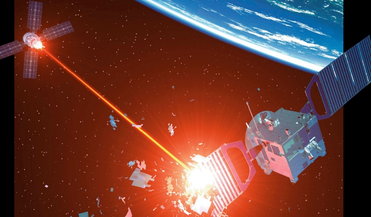ROOM: The Space Journal is one of the prominent magazines on space exploration, technology and industry. At ROOM, we share a common goal – advancement of peaceful space exploration for the benefit of humankind, all while bringing you incisive articles on a plethora of interesting topics. Our authors include researchers and industry leaders from all over the world, which lets us bring you timely and accurate information about space magazine our legacy.
 June 2022
Space logistics: achieving end-to-end mobility for space
June 2022
Space logistics: achieving end-to-end mobility for space
... water and air using more and more sophisticated and organised networks. Lately, we have extended our reach to space, but so far with limited capability of movement between orbits, satellites are effectively ‘trapped’ ... even further. As the first cornerstones of this new space industry era, commercial constellations are being deployed at an unprecedented rate by both start-ups and legacy actors: OneWeb, Starlink or Telesat for broadband; Kineis,...
 August 2016
The promise of space tourism
August 2016
The promise of space tourism
... it’s the desire to have a life-changing view of Earth from orbit or to float weightless in space as in our flying dreams. Advances in private space travel, once the domain of a privileged few, are about to make it possible for everyday people... them to see the world in new and extraordinary ways. The benefits from exploring space touch our lives every day. Space travel has given us everything from the inspiration of watching humans first set foot ...
 February 2020
Visions of spaceflight before the Space Age
February 2020
Visions of spaceflight before the Space Age
...peaks in the world, the deepest regions of the oceans, or outer space and our planetary neighbours, travellers have used books and magazine articles to document their adventures. In this article, adapted from Foreword to ...weapons of war (up, and then down). This is a dilemma with which rocketeers have struggled, but it is a legacy that we must acknowledge and understand. The development of the V-2 rocket by Germany during World War II was a ...
 July 2019
Stepping into space with STEAM
July 2019
Stepping into space with STEAM
... and integrity, not brashness and ego. And, first and foremost, we’d better ensure our home is well taken care of. Humanity’s legacy must be doing it better. The citizens and leaders, skills and solutions that will...the community. Holly is on the advisory boards for global organisations such as Space Vault, Finsophy, and STEM for Women magazine. She also sits on the Space Economy Task Force in Austin, Texas. Jeff Smith is a Material Control Analyst...
 May 2022
Essential guide to the James Webb Space Telescope
May 2022
Essential guide to the James Webb Space Telescope
... we cannot imagine the universe the James Webb Space Telescope is about to reveal. WST is not ‘Hubble’s Replacement’ but ‘Hubble’s Successor’, designed to build on Hubble’s rich legacy and even to work side-by-side with the ... - invisible to Hubble but exactly poised for JWST. Another motivation for selecting an infrared space telescope comes from our recent advances in the field of exoplanets; worlds orbiting other stars. With over 5000 known...
 February 2021
Space archaeology - preserving our orbital heritage
February 2021
Space archaeology - preserving our orbital heritage
... they should not prevent us from examining the significance of these artefacts which represent the legacy of our exploration beyond the cradle of our birth into a wider universe. More important than just providing a list of items is ... how incredible the space-based activities of humans in the late 20th and early 21st centuries would seem. Preserving key pieces of hardware and items from our orbital heritage would seem to be a legacy that is not ...
 September 2023
The Institute of Biomedical Problems - Sixty years of contributing to the development of space biomedicine
September 2023
The Institute of Biomedical Problems - Sixty years of contributing to the development of space biomedicine
... it possible to gain a deeper understanding of the regular patterns of body adjustment to the effects of space flight factors and to make significant progress in understanding a number of fundamental problems of gravitational physiology and ...have been repeatedly recognised with Grand Prix, gold, silver and bronze medals and diplomas. Knowledge legacy During 60 years of fruitful work, IBMP RAS has made a significant contribution to the development...
 October 2018
Using space-based data for humanitarian causes
October 2018
Using space-based data for humanitarian causes
...it under the same microscope. This is not a problem unique to remote sensing technology but is a true legacy of human rights law. As human rights law emerged in the post-World War II era, states were ... of Mississippi School of Law, and his courses at the University of North Dakota include space law, history of the space age, space politics & policy, space & the environment, and remote sensing law & regulation. He has been a contributor to...
 June 2022
Military space – how worried should we be?
June 2022
Military space – how worried should we be?
...space and ‘civilian’ space, with an all-civilian space agency, NASA. The government and media portrayal of early space was unmistakably ‘peaceful purposes’: see the film The Right Stuff, read the US-published Colliers magazine... or Russia’s Teknika Molodezh, admire Mosfilm productions. No missiles there. At the same time, there was a parallel, typically obscured, track of military space development. The same ...